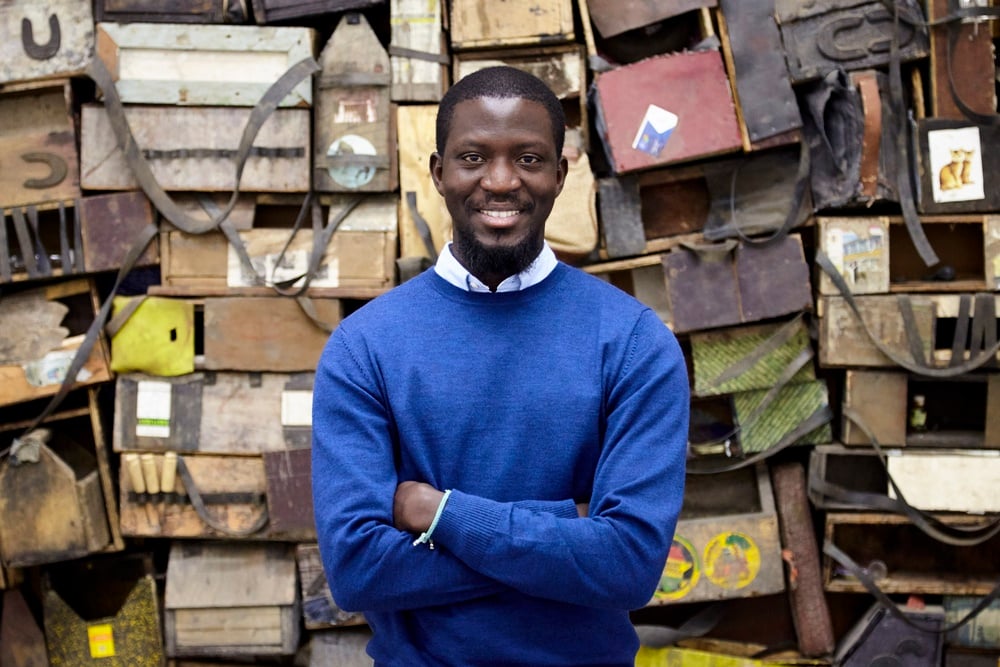
As organizers prepare to launch the ninth edition of Frieze New York on Randalls Island next week, they’re also opening the fair beyond its traditional confines with a new platform, Frieze Sculpture, at Rockefeller Center.
The inaugural free public art show, which will remain on view through late June, features 20 sculptures from 14 local and international artists, including Ibrahim Mahama, a young Ghanaian artist who has already garnered international attention for his transformational use of materials. The program is the brainchild of Loring Randolph, the artistic director for Frieze Americas, who enlisted Brett Littman, director of the Isamu Noguchi Foundation and Garden Museum in Long Island City to curate the platform.
Mahama—who is represented by White Cube and was featured in the 2017 Venice Biennale—is known for his explorations of commodity, migration, globalization, and economic exchange. For Rockefeller Center, the artist created 50 jute flags in Ghana—they are interspersed among the flagpoles for the usual 192 UN flags that normally wave in the plaza.
artnet News caught up with artist to talk about the inspiration for the project and how it all came together.
Tell me how the project came about. When did Frieze first contact you and why did they feel that you were a good fit?
I was invited to respond to the poles in January this year and I immediately thought it was an interesting idea. A few years ago, I produced a series of flags for the occupation of a 17th-century building that had been demolished in Accra, Ghana. The destruction of history in conversation with the sets of failures recorded within the jutes sacks was a topic that I had wanted to explore. The flags themselves are not necessarily what I think of as being the sculpture; however, the entire space and forms that they create are. The poles help complete the idea of the sculpture.
How did the location influence or inspire the work that you created?
To begin with, it is a beautiful site already identifiable by its many flags. These embody and call back to a lot of history and memories. The architecture that surrounds it also influenced the form of the work.
Tell me about the installation itself, what you created, and why.
The installation itself is a combination of different materials used traditionally in the transportation of food and other commodities around the world. These containers gather a lot of memory over time as they encounter various forms of labor. These labor forms are mostly unaccounted for once the commodities reach their destination due to the system of global trade. In the 1950s and ’60s, Ghana was the largest producer of cocoa in the world. A lot of the money that was generated from its exportation was used in infrastructural projects, many of which were abandoned after the coup in 1966. That was a time dedicated to economic independence through infrastructural developments, which to some extent failed due to external forces constantly intervening. I believe that it is important to allow true independence for labor to be fully appreciated in these current times. The issue of exploited labor is a global one, and I wanted to address that through the form of this installation.
Flags sometimes are supposed to represent the idea of freedom, but they can also be a symbol of oppression. I am interested in the combination, and how it manifests itself in the character and experience of the artwork. All the flags are handmade and sewn. Each flag has two different sides and is animated by the wind within the architecture of the Rockefeller Center. I simply wanted to make a decaying flag, out of objects that are a manifestation of our 21st-century condition, but that also hold a sense of hope.
Lastly, the installation gets to live as a contradiction to itself through the form that it takes.
How does it feel to have your work on view to such a large audience? Exciting? Intimidating?
I have always exhibited my work in public spaces that have attracted large audiences, but I also think that every site holds a specific context, so the reading of the work will change. I find this to be very exciting. There are always so many meanings that are created in the process and manifestation of the different works, and I find this inspiring.
What, if anything in particular, do you hope that people will take away from this installation and why?
It is important to read beyond the obvious form of the work. The materials used in the production have been collected from many different sites around the world and embody the state of the human condition in the 21st century. Paradoxically, the formal qualities of the work speak towards that, but it is also very easy to overlook the details because of its mundane nature. The world has to pay attention to the mundane, as it can prove to be very transformative in our vision and response to our communities.
Frieze Sculpture will be on view at Rockefeller Center through June 28.